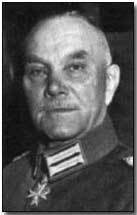Georg von Bruchmüller
From Kaiserreich
|
Georg von Bruchmüller (born Georg Bruchmüller on December, 11 1863 in Berlin, Germany) is a German artillery officer. Also known as Durchbruchmüller (contraction between German for "breakthrough" and his name), he was one of the greatest developers of modern artillery tactics.
Contents |
Biography
Early life
Bruchmüller was born in Berlin into of a middleclass family and joined the Imperial Army in 1885. He started his career at in the Fußartillerie (foot artillerie), the branch of the German Army armed with heavier guns, howitzers and mortars, designed principally for siege warfare, but which also had a role in mobile and static warfare in the field.
In 1897 and 1898, Bruchmüller served as a battery commander in Fußartillerie-Regiment Nr. 3 in Mainz.
In 1901 and 1902, Bruchmüller served as a battery commander in the Lehr-Bataillon of the Royal Prussian Fußartillerie-Schießschule [Foot Artillery Firing School] in Jüterbog. During this time, he worked with one of the instructors at the Fußartillerie-Schießschule, Hauptmann Arthur Bilse, a heavy artillery specialist who rose to general officer rank during the First World War and, while serving as General der Fußartillerie 15, was killed in action on New Year's Day of 1916 at Les Baraques, France.
Bruchmüller retired from active duty after a riding accident.
Weltkrieg
At the beginning of the Weltkrieg he was reactivated and became artillery commander of the 86. Infantry Division at the Eastern Front. Bruchmüller developed techniques to support attacks with a sudden concentration of accurate fire instead of prolonged preparatory bombardments. In the spring of 1916 he convinced the chief of staff of the Tenth Army to adopt this method of concentration for a major attack at Tarnopol, and the effect in supporting the rapid advance of the infantry was impressive.
Bruchmüller's technique emphasized fire in depth throughout the enemy positions. His support included an accurate creeping barrage, the Feuerwalze, for the advancing infantry.
Bruchmüller developed several techniques to achieve disruption, which required strict control of all artillery assets. Each battery of each type of weapon received specific fire missions with specific timetables. He organized it in three stages of delivery of fire. The first consisted of surprise, concentration, hitting headquarters, phone links, command posts, enemy batteries, and infantry positions. The fire was sudden, concentrated, and made extensive use of gas. The second stage required that the other batteries reinforced those batteries already firing on enemy batteries. The third stage asked for fire for effect on designated targets according to range. Some batteries continued to shell infantry positions, heavy pieces engaged long range targets.
To achieve maximum disruptive effect on the enemy, surprise was essential. Thus, the Germans concealed their attack preparations very carefully and their initial target data had to be very accurate. Bruchmüller rose in position in the east, commanding the artillery of von Hutier's Eighth Army at Riga in September 1917. When his unit was transferred to the west in late 1917, Bruchmüller arrived in time to participate in the Cambrai counterattack. He received the Pour le Mérite the same year, being one of the fourth senior artillery officers to receive this honour.
During the 1919 offensive, Bruchmüller was one of the commanders of the siege of Paris. His constant and daily bombing of the French capital was determinant in the final surrender of the defenders of the city. He was later transferred to the Italian front, where he proved all his talent during the battle of Monte Cassino, where the Central Powers and the last Italian forces stopped the advance of the Italian Sydnicalists.
Post-Weltkrieg
Being very aged in 1921, Bruchmüller retired from active duty with the rank of General. Due to his great and impressive role during the Weltkrieg, he is ennobled by the Kaiser Wilhelm II in 1922, one of the few in the German Army to receive such an honour. Refusing to engage in politics, he is recognized as one of the best strateges of the war, most of the German artillery engagements after the Weltkrieg (such as in China in 1926) having been inspired by Bruchmüller's techniques. He was made nominal commander of the Siegfried line in 1932. Despite being officially retired, he often declares to be ready to serve Germany in case of emergency.

